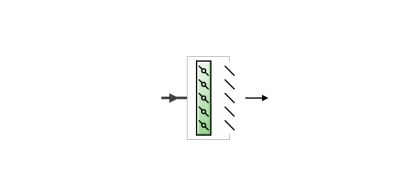
The Variable Air Volume Outdoor Air terminal unit is intended for use in single duct systems for modelling centralized dedicated outdoor air (DOAS) distribution system when the required volume of outdoor air varies over time. The component is based on the EnergyPlus AirTerminal:DualDuct:VAV:OutdoorAir which provides dual duct air system in which one duct provides outdoor air ventilation and the other provides VAV cooling. However DesignBuilder uses only the outdoor air stream for modelling DOAS and the cooling duct is not used.
The terminal unit is meant for systems regulating outdoor air based only on demand control or code minimum settings and not on economizer operation. This air terminal does not have heating coils and is not configured for conditions zones that need heat. Additional ZoneHVAC equipment, such as baseboards or fan coil units, are needed to provide heating to the zone.

This is a read-only label that is automatically generated by the software and which incorporates the name of the zone in which the ADU is located.
Max total airflow rate (m3/s or ft3/min) at the terminal unit outlet including both the Outdoor Air stream and the Recirculated stream. Can be autosized based on the Air loop Design outdoor airflow rate and the zone thermal cooling load. The autosized flow rate will be the sum of the maximum outdoor air requirement and the flow for cooling. When autosizing, this maximum and the individual inlet flow rate sizes are reported to the eio file.
This option is used to select how outdoor air ventilation rates are calculated when based on a rate per person. It can be either based on the current number of people as affected by time-varying occupancy schedules, or on the constant value for the maximum number of people. Choose one of:
Note: this setting is only used when outdoor air ventilation rates are calculated when based on a per person rate.
This is the schedule that determines whether or not the unit is available for each timestep of the simulation. A schedule value greater than 0 (usually 1 is used) indicates that the unit can be on during the timestep . A value less than or equal to 0 (usually 0 is used) denotes that the unit must be off for the timestep.